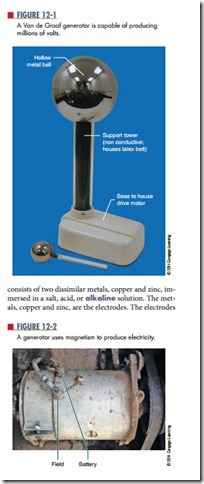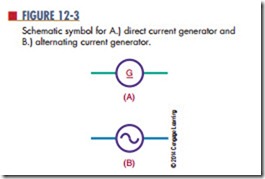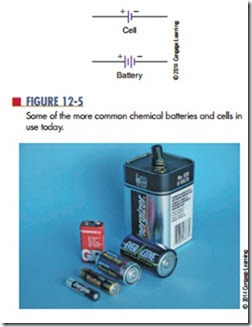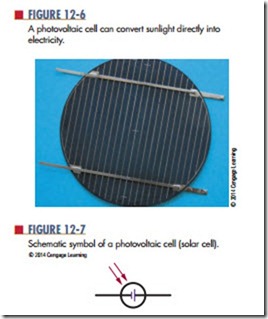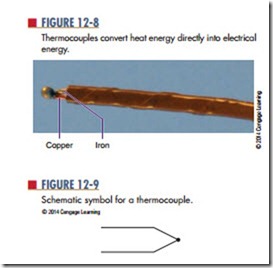In a piece of copper wire, the electrons are in random motion with no direction. To produce a current flow, the electrons must all move in the same direction. To produce motion in a given direction, energy must be imparted to the electrons in the copper wire. This energy comes from a source connected to the wire.
The force that causes the electrons to move in a common direction is referred to as difference of potential, or voltage. This chapter examines how voltage is produced.
Voltage Sources
A current is produced when an electron is forced from its orbit around an atom. Any form of energy that dislodges electrons from atoms can be used to produce current. It is important to note that energy is not created; rather, there is simply a transfer of energy from one form to another. The source supplying the voltage is not simply a source of electrical energy. Instead, it is the means of converting some other form of energy into electrical energy. The six most common voltage sources are friction, magnetism, chemicals, light, heat, and pressure.
Friction is the oldest known method of producing electricity. A glass rod can become charged when rubbed with a piece of fur or silk. This is similar to the charge you can generate by scuffing your feet across a carpet in a dry room. A Van de graaf generator is a device that operates using the same principles as the glass rod and is capable of producing millions of volts (Figure 12-1).
Magnetism is the most common method of producing electrical energy today. If a wire is passed through a magnetic field, voltage is produced as long as there is motion between the magnetic field and the conductor. A device based on this principle is called a generator (Figure 12-2). A generator can produce either direct current or alternating current, depending on how it is wired. When electrons flow in only one direction, the current is called direct current (Dc). When electrons flow in one direction and then in the opposite direction, the current is called alternating current (ac). A generator may be powered by steam from nuclear power or coal, water, wind, or gasoline or diesel engines. The schematic symbol for a DC genera- tor and an AC generator is shown in Figure 12-3. The second most common method of producing electrical energy today is by the use of a chemical cell. The cell
establish contact with the electrolyte (the salt, acid, or alkaline solution) and the circuit. The electrolyte pulls the free electrons from the copper electrode, leaving it with a positive charge. The zinc electrode attracts free electrons in the electrolyte and thus acquires a negative charge. Several of these cells can be connected together to form a battery. Figure 12-4 shows the schematic symbol for a cell and battery. Many types of cells and batteries are in use today (Figure 12-5).
Light energy can be converted directly to electrical energy by light striking a photosensitive (light-sensitive) substance in a photovoltaic cell (solar cell) (Figure 12-6). A solar cell consists of photosensitive materials mounted between metal contacts. When the surface of the photosensitive material is exposed to light, it dislodges electrons from their orbits around the surface atoms of the material. This occurs because light has energy. A single cell can produce a small voltage. Figure 12-7 shows the schematic symbol for a solar cell. Many cells must be linked together to produce a usable volt- age and current. Solar cells are used primarily in satellites and cameras. The high cost of construction has limited their general application. However, the price of solar cells is coming down.
Heat can be converted directly to electricity with a device called a thermocouple (Figure 12-8). The schematic symbol for a thermocouple is shown in Figure 12-9. A thermocouple consists of two dissimilar metal wires twisted together. One wire is copper and the other wire is zinc or iron. When heat is applied to the twisted connection, the copper wire readily gives up free electrons, which are transferred to the other wire. Thus the copper wire develops a positive charge and the other wire develops a negative charge, and a
small voltage occurs. The voltage is directly proportional to the amount of heat applied. One application of the thermocouple is as a thermometer. Also called a pyrometer, these devices are often used in high-tem- perature kilns and foundries.
When pressure is applied to certain crystalline materials such as quartz, tourmaline, Rochelle salts, or barium titanate, a small voltage is produced. This is referred to as the piezoelectric effect. Initially, negative and positive charges are distributed randomly throughout a piece of crystalline material, and no over- all charge can be measured. However, when pressure is applied, electrons leave one side of the material and accumulate on the other side. A charge is produced as long as the pressure remains. When the pressure is removed, the charge is again distributed, so no over- all charge exists. The voltage produced is small and must be amplified to be useful. Uses of the piezoelec- tric effect include crystal microphones, phonograph pickups (crystal cartridges), and precision oscillators (Figure 12-10 and Figure 12-11).
Note that although a voltage can be produced by these means, the reverse is also true; that is, a voltage can be used to produce magnetism, chemicals, light, heat, and pressure. Magnetism is evident in motors, speakers, solenoids, and relays. Chemical activities can be produced through electrolysis and electroplating. Light is produced with lightbulbs and other optoelectric devices. Heat is produced with heating elements in stoves, irons, and soldering irons. And voltage can be applied to bend or twist a crystal.
schematic diagram of a piezoelectric crystal.
Questions
1. What are the six most common voltage sources?
2. What is the most common method for producing a voltage?
3. What is the second most common method for producing a voltage?
4. Why are solar cells not used more for producing a voltage?
5. What determines current flow with the piezoelectric effect?
6. What are the results when voltage is applied to produce magnetism, chemical, light, heat, and pressure?
